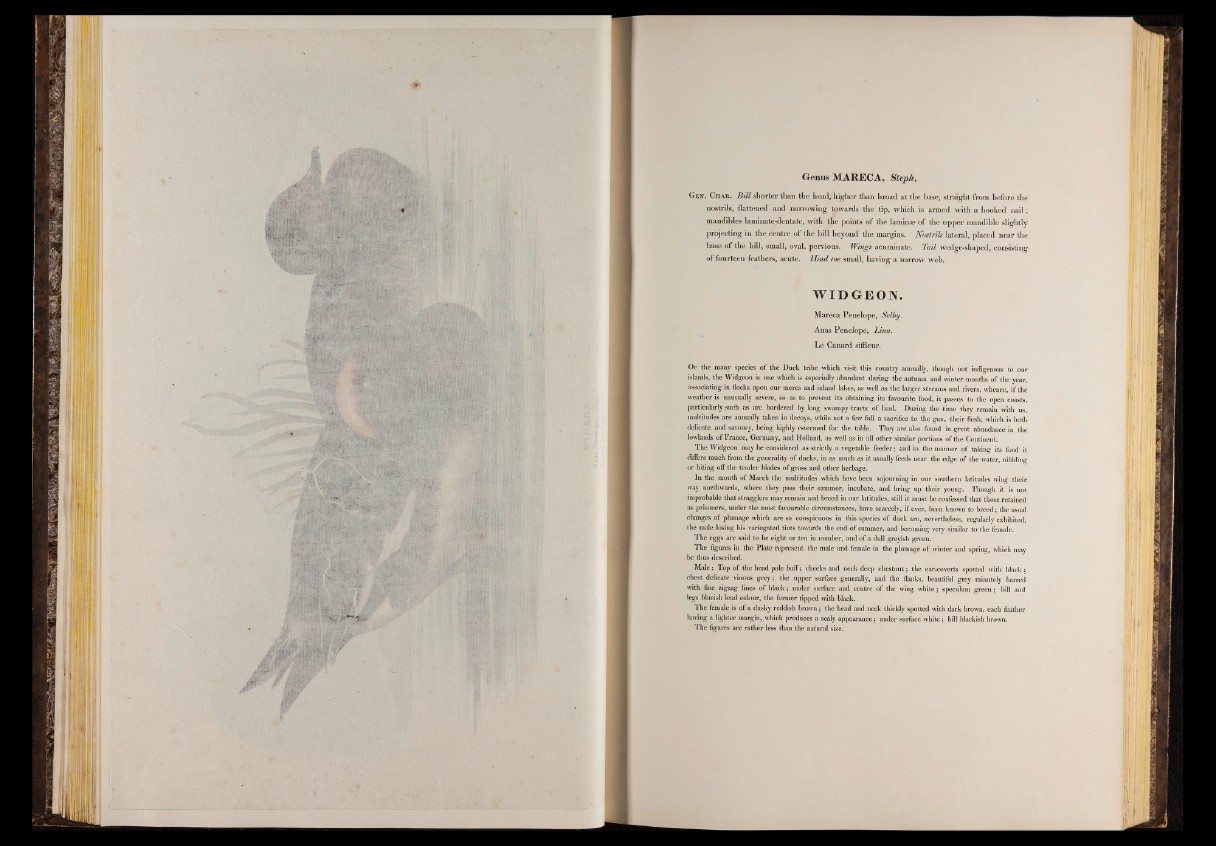
Genus MARECA, Steph.
G e n . C har. B ill sh o rte r th an th e h e ad , h ig h e r th a n b ro ad a t th e base, s tra ig h t from before th e
nostrils, fla tten ed an d n a rrow in g towa rd s th e tip , which is a rm ed w ith a h o oked n a i l ;
m an d ib les laminate-dentate, w ith th e po in ts o f th e laminas o f th e u p p e r m an d ib le slig h tly
p ro je c tin g in th e c en tre o f th e b ill b eyond th e margins. Nostrils lateral, placed n e a r th e
base o f the. b ill, small, oval, pervious. Wings acuminate. Tail wedge-shaped, consisting
o f fo u rte en feathers, acute. Hind toe small, h av in g a n a rrow web.
WIDG EON .
Mareca Penelope, Selby.
Anas Penelope, Linn.
Le Canard siffleur.
Of the many species of the Duck tribe which visit this country annually, though not indigenous to our
islands, the Widgeon is one which is especially abundant during the autumn and winter months of the year,
associating in flocks upon our meres and inland lakes, as well as the larger streams and rivers, whence, if the
weather is unusually severe, so as to prevent its obtaining its favourite food, it passes to the open coasts,
particularly such as are bordered by long swampy tracts of land. During the time they remain with us,
multitudes are annually taken in decoys, while not a few fall a sacrifice to the gun, their flesh, which is both
delicate and savoury, being highly esteemed for the table. They are also found in great abundance in the
lowlands of France, Germany, and Hollaud, as well as in all other similar portions of the Continent.
The Widgeon may be considered as strictly a vegetable feeder; and in the manner of taking its food it
differs much from the generality of ducks, in as much as it usually feeds near the edge o f the water, nibbling
or biting off the tender blades of grass and other herbage.
In the month of March the multitudes which have been sojourning in our southern latitudes wing their
way northwards, where they pass their summer, incubate, and bring up their young. Though it is not
improbable that stragglers may remain and breed in our latitudes, still it must be confessed that those retained
as prisoners, under the most favourable circumstances, have scarcely, if ever, been known to breed; the usual
changes of plumage which are so conspicuous in this species of duck are, nevertheless, regularly exhibited,
the male losing his variegated tints towards the end of summer, and becoming very similar to the female.
The eggs are said to be eight or ten in number, and of a dull greyish green. '
The figures in the Plate represent the male and female in the plumage of winter and spring, which may
be thus described.
Male: Top of the head pale buff; cheieks and neck deep chestnut; the ear-coverts spotted with black;
chest delicate vinous grey; the upper surface generally, and the flanks, beautiful grey minutely barred
with fine zigzag lines of black; under surface and centre of the wing white; speculum green ; bill and
legs blueish lead colour, the former tipped with black.
The female is of a dusky reddish brown; the head and neck thickly spotted with dark brown, each feather
having a lighter margin, which produces a scaly appearance; under surface white; bill blackish brown.
The figures are rather less than the natural size.